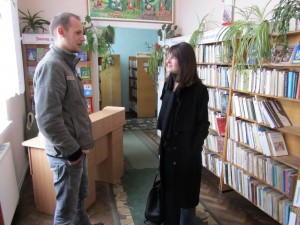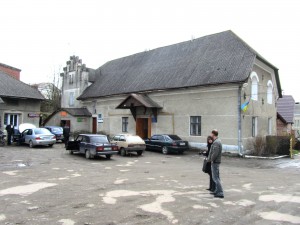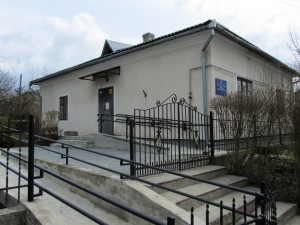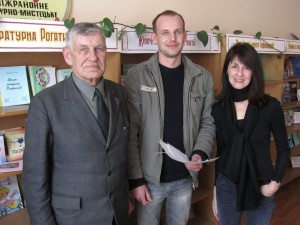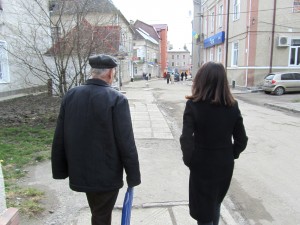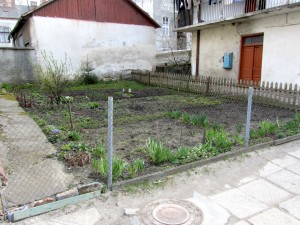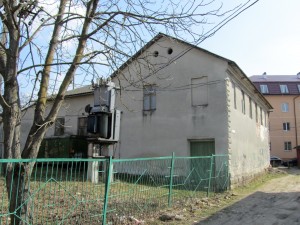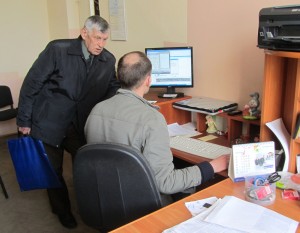The following is a summary of our 13 April 2011 visit to Rohatyn. This, as you already know, was our second trip since having landed in Lviv the end of March.
We arrived in Rohatyn by rental car just before noon, after having booked a room for the night at Hotel Fortuna in Cherche, 5 kilometers away. We were to meet Ihor Klishch, the young Rohatyn library manager, for a tour of the library, then take lunch at Cafe Victor on Halytska Street, facing the Rynek. We parked the car in front of the library, facing the bronze bust of Ivan Franko and the now largely dormant Rohatyn cinema (“Kino”).
![]() Ця стаття також доступна українською.
Ця стаття також доступна українською.
Ihor spotted us getting out of the car, and he was coming out of the library door when we turned around. He gave us each a warm smile, handshake, and hug.
As promised, we toured the library (the internet room and the location of the manager’s office, the reading room, and the children’s book and reading room) and discussed library challenges in Ukraine, and then went for lunch. After lunch we walked down Halytska Street. Ihor had promised to show us the “courtyard” which appeared in an old Rohatyn postcard that Alex Feller had found; we would not have been able to find its location on our own, despite the uniqueness of one of the building’s crow-stepped gable, had Ihor not led us there. Today, the courtyard is tucked behind a low but modern structure on Halytska Street and filled with diverse repair facilities and small businesses; none of the lush greenery from the old postcard photo still exists. Ihor explained he was told that at one time, the long building appearing in the old photo on the right had had a basement prison circa 1939, thereafter a warehouse.
We then continued along Halytska Street past today’s modern, Soviet-era high-rise State administrative building, heading for the town museum. On the way we passed the former small street passage known as Wuzka (or Wazka), where, according to post-War Stanislawow casualty records compiled by the Soviets, at least three (if not four) Horn families had lived here (including Fruchter and Liebling). What we found was today a partly-paved, partly-dirt walking path that wound its way from Krypyakevycha Street (along which runs Babinka creek) past a couple of older houses and into a modern high-rise common area with playground, leading to a passage to the southwest corner of the Rynek. (Once we got home and we closely examined the 1944 German aerial photo of Rohatyn, we could easily see that Wuzka had had a similar path at one time – but unbroken and appearing paved – along which had been 3 or 4 houses, with the road branching to several short streets south of the Rynek).
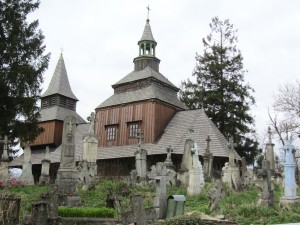
Church of the Holy Spirit. Photo by Jay Osborn for Wikimedia Commons.
Ihor then took us for an organized tour of the Rohatyn town museum, located in a small building on the site of a prominent former artist’s residence, just south of the former Judenrat building (today a school for orphans and children with disabilities). A museum docent (Maryana) gave us a tour of the collection, followed by a tour of the late-16th c. wooden church of the Holy Spirit (which has applied for UNESCO status). Both places were interesting and informative, the former confirming that the Rohatyn Rynek once had a tall clock tower in the middle of the square and that the city had once been surrounded by fortress-like stone walls. A part of these walls (now gone) once ran along former Nove Miasto Street, today called Kudryka.
From there we walked back into town to find an espresso before meeting with school teacher and local historian, Mr. Mikhailo Vorobets, scheduled for 4:00 p.m. at the library. When we emerged from the cafe we made a turn and unexpectedly ran into Mr. Vorobets who was hurriedly walking toward the library to be early for the meeting. We greeted and headed back to the library to begin the meeting; Ihor had already arranged for the four of us to use the library’s main reading room for this purpose.
We spent about two and a half hours talking with Mr. Vorobets; Ihor acted as translator. Mr. Vorobets had brought with him a folder of hand-written notes, lists, and documents, as well as newspaper clippings (mostly from the 1998 dedication of the Jewish memorials) and a few photos. I had my computer open with all my Rohatyn files and photos available to me. Jay acted as note-taker and photographer. Mr. Vorobets was warm, talkative, and energetic; he came prepared to share with us whatever he had that we were interested in. Naturally, discussions were a bit cumbersome and confused at times, as there were a lot of topics we and he wanted to cover, and Ihor had to translate in both directions. All of Mr. Vorobets’ research notes were, of course, hand-written in Ukrainian. A summary of our discussions with Mr. Vorobets is further below.
At around 6:30 p.m., everyone was fatiguing. Ihor agreed to use the library’s scanner to scan the various lists, notes, and documents that Mr. Vorobets willingly offered us. Given the incompleteness of our notes and the rush of the meeting, Jay and I figured it would be best to have scans of Mr. Vorobets’ original notes and papers for deciphering – and translating – later.
As Ihor began scanning the documents, Mr. Vorobets took my arm and motioned for us to take a walk. We did, briskly, with Jay following closely behind to shoot snapshots. First stop from the library was up Ivan Franko Street, in the direction of the Rynek; Mr. Vorobets pointed out a private garden between two houses, where unseen under the soil silently lie an unknown number of Jewish headstones; he estimates as many as 13-15. Plans are in the works by us to have these stones unearthed and moved to the “new” Jewish cemetery for safe-keeping; but more about this below and in a future posting to the group.
From there, we backed up to Mitskevycha Street and turned south. Mr. Vorobets sped along ahead of me, excitedly speaking in Ukrainian (knowing I don’t speak a word!). I recognized the words “Doctor Leventer” and knew that he wanted to show me the house that had once belonged to this prominent Rohatyn Jewish family; I knew this because, during our meeting, Mr. Vorobets had showed us a list he had compiled since 1998 of some of the houses still standing that once belonged to Jewish families; on that list we recognized the names Horn, Leventer, Kreisler, Goldschlag, Amarant, Wind, Kartin, and Mark (discussed further below). When we reached Shevchenko Street, we hurried across to look back: there at the corner of Mitskevycha and Shevchenko was a pinkish two-story building with balconies. “Doctor Leventer”, Mr. Vorobets kept repeating, pointing to the building. Today, a couple doors to the right of this building, is the Rohatyn city administration building.
From there we rushed east up Shevchenko Street toward the large Ukrainian high school building and grounds where Mr. Vorobets still teaches. From there we briskly headed north to the area behind the dormant “Kino” cinema (where we parked our car) where a synagogue had once served the Jewish community; today it is a sad, badly remodeled structure that is largely boarded up. We could not see any architectural clues suggesting this building’s once Jewish past.
We returned to the library just as Ihor was finishing the scanning. Mr. Vorobets seemed rather sad that our visit was ending, and I thought I detected watery eyes when he kissed my hand good-bye and touched his heart. I had tears in my eyes. Ihor walked us out to our car where we all hugged and promised to be in touch again very soon.
After leaving Ihor, we visited and photographed a few more sites around town and then drove to the Elite Center Hotel on the southern edge of Rohatyn, near the railroad tracks, where we ate a much-needed dinner. We then returned to the Fortuna Hotel in Cherche, catching a few hours of restless sleep before rising early the next day to photograph nine more towns between Rohatyn and Lviv where Rohatyners had had family or connections. We returned the rental car to the Lviv airport just before 6:00 p.m. on Thursday.
Notes from the Discussion with Mr. Vorobets
The following summarizes discussion with Mr. Vorobets at the library, with Ihor acting as translator. I apologize in advance for brevity and imprecision in our notes – Jay and I were not only furiously writing to keep up with the information, but simultaneously also trying to listen and ask more questions!
The notes are arranged by topic, as several have accompanying documents (in Ukrainian, for now), linked further below:
1. About Mr. Vorobets.
He was born in 1934, so was only about age 7 during the height of the War. He heard and saw things but did not comprehend them at the time, and filled in his understanding when older. For example, after the first Aktion, a friend of his father’s came to the Vorobets home and asked his father if they (father and son) wanted to come see where the Jews had been killed and buried. He went with his father and saw two trenches – the bodies were covered but there was blood everywhere and the ground was still moving in places. He was very upset seeing all this and asked to be taken away. Mr. Vorobets has assembled some historical details about families, houses, occupations, and life in the Jewish community, as part of his larger work collecting history of the town; these notes are unpublished to-date. A few of them were scanned during our visit and the link to them is below.
2. Partial list of buildings of Rohatyn Jewish families still standing.
Created by Mr. Vorobets following the 1998 Jewish memorial dedications, this list was made from interviews personally conducted by him with elderly townspeople, now deceased, who had direct memories of the War and Jewish families in Rohatyn. Addresses appearing beside surnames had at least two witnesses to corroborate. (Some of these building locations have been previously identified by families of our group members, e.g. Jack Glotzer and Herman Skolnick). Names on this list include, for example, Horn (at #3 Kotsyubyns’koho Street, located just behind the end building on the Rynek next to the Ukrainian Church; today this building is owned by the nearby school), Kreisler, Goldschlag, Mark, Amarant (today, #28 Halitska), Kartin, Leventer, and Rothbaum (sp?), to name a few.
3. Partial list of Jewish pupils at the Ukrainian high school.
In the 1912-13 list, the name “Horn, Taube” appears, for example. The name “Taykhman Samuil” (Teichman) appears in the 6th grade.
There are many, many other surnames, but they need translating!
4. Aktions.
Although I have only ever read of three Aktions in Rohatyn, Mr. Vorobets says that according to records located at the Archives in Ivano-Frankivsk, there were four, the dates being as follows: 20 March 1942, 21-22 September 1942, 8 December 1942, and 6 July 1943. (Regarding this last one – July, 1943 – I had always understood this Aktion took place in June, so I don’t know if this is an error or a correction).
In the first Aktion, there was a Jewish man named Fleischlager (sp?) who jumped into the open trench even though he had not been shot; he survived by climbing out after the killings. Later on, he returned to Rohatyn’s ghetto and was holding a pail for water when he was stopped by the SS. An SS officer allowed him to go get the water, and from there he escaped and joined the Soviet army. Mr. Vorobets believes he may have subsequently been killed in action.
5. Polish Red School document of David Baumrind.
Sent to Mr. Vorobets from Israel, this document was some sort of hastily issued graduation certificate from 1941, just weeks before the German army invaded the town.
6. Judenrat.
List of the members of Judenrat (at one time), which apparently includes these names: Amarant (as head), Dr. Holtstein (sp?), Eli Kreisler, Dr. Freiwald, Dr. Holtvort (sp?), Feivel Goldschlag, Dr. Rosenstein (sp?), and Michael Katz.
7. Pukiv story.
There was a Jewish teacher from this town named Anatoly Engelberg. He and his wife were forced into the Rohatyn ghetto. Their son elected to go to Rohatyn with them, knowing he would die there and because he wanted to die with them. This story was taken by Mr. Vorobets from Rohatyn town elders post-1998.
8. Mr. Vorobets’ neighbor’s story.
Three Jews hid in the basement of a chapel in town (location not specified in our meeting) who were denounced and killed by the Nazis. Mr. Vorobets’ neighbor, a women, who saw this happen, told him this in her interview by him. (Appears in testimony list, link below).
9. Sabina Wind family.
House #101 Halytska – still standing today. This house belonged to the family of Sabina Wind, whom Mr. Vorobets met in 1997 and/or 1998 along with Fishel Kirschen, Mordechai Fuks, and someone named Perl. Sabina and her family, per Mr. Vorobets, hid in the basement of the building that is today the town’s Courthouse. A Ukrainian man named Onufriy kept them alive by smuggling food to them.
10. Jewish headstones around town today.
According to Mr. Vorobets, there are over a dozen pieces of Jewish headstones located in several places around town (not in either cemetery). As mentioned above, for example, at least a dozen are supposedly buried in a private vegetable garden up the street from the library. When stones were unearthed in recent years, Mr. Vorobets contacted Boris Arsen (see Odds ‘n’ Ends discussion, below) and arranged for them to be moved to the “new” Jewish cemetery (this cemetery – with links to our photos taken during our 4 April 2011 visit to Rohatyn – were included in a prior posting to the group). In addition to the vegetable garden, there are one or more pieces stacked behind the Courthouse (today, next to the former Sokol) after being unearthed during recent excavation work in town installing new communication lines. At present, we are working on making formal arrangements for the collection and transportation of all known detached Jewish headstones (and pieces of headstones) to the “new” Jewish cemetery, where the remains of other headstones are already located. We will try to photograph any of these headstones moved by the time of our next visit to Rohatyn (with Alex Feller) on 13 May, and will make arrangements for moving and documenting the rest later, using local contacts, once we have concluded our time in Lviv in mid-June.
11. Odds ‘n’ Ends.
There were three soccer teams in town (Jewish, Ukrainian, and Polish), and they practiced in what is today the mostly dormant cinema (“Kino”) building opposite the library on Ivan Franko Street. The: Jewish team called itself the Maccabees.
The Rohatyn town archives, located on today’s Halytska Street, may have pre-War records. The museum we visited may have some inter-War records. Whether any of these are of Jewish families (or exist at all) is unknown. We will make inquiries through Ihor before our next 13 May visit.
“My Bitter Truth” – a book written by Boris ARSEN, a Rohatyner who survived the War and then moved to Ivano-Frankivsk.
Scans of the documents and photos from Mr. Vorobets are here: http://www.pbase.com/nuthatch/ua_20110413_vorobets
As before, click on a thumbnail to see it larger. Underneath the enlarged image, you can click on the word “original” to see the document at full resolution, for better reading or for downloading.
Photos of our day in Rohatyn are here: http://www.pbase.com/nuthatch/ua_2011_rohatyn_t
In a separate posting to the group will be English translations to the above documents, as these translations become available. In the meantime, for those of you who read Ukrainian, please feel free to enlighten the rest of us!
[Note: This report was originally sent by Marla to the Rohatyn District Research Group.]

